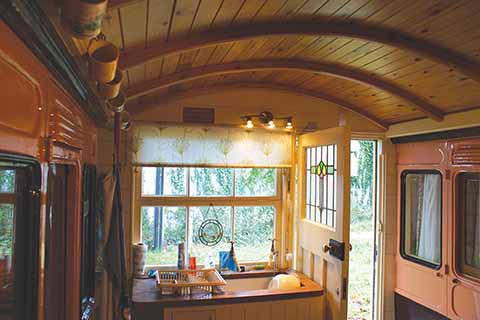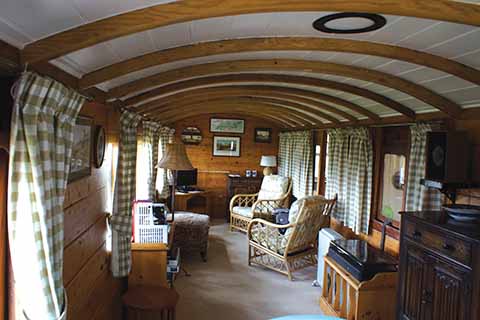The Railway Carriage Children
Joël Lacey tells the story of a house in Wool built from two railway carriages
Published in March ’19

Sybil with friends Nesta and Betty and Alfred standing in front of the large barrel that was used to lower the carriages from the road trailer
Probably the most touching book that I have read in a long time had a very short run. Just two copies of Granny’s Trainhouse were produced by the mother of David and Alison Saunders. The book starts with a fascinating family history leading up to the marriage of Alfred and Fanny, and then of the family’s history with their two daughters, Esmé and Sybil and their trips down to Dorset.
After years of coming down to Wool to stay with relatives, Albert and Fanny decided they should build their own house for use as a holiday home. Albert bought a plot of land next to what is now the Wool & Bovington Motors garage on the main road. His genius was in deciding how his house was going to be built.
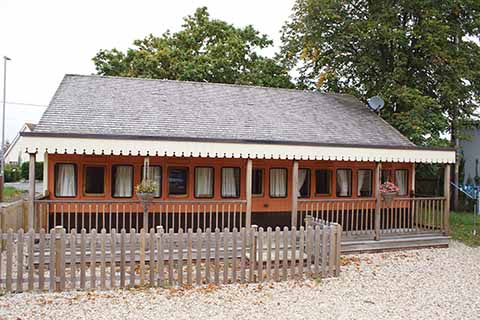
The garden side of Granny’s Trainhouse, with the carriages in their original salmon and chocolate, with its smart new veranda
In 1923, Albert bought a pair of old railway carriages that had been used to transport returning injured soldiers from the Channel ports after the end of World War 1.
The carriages had at that point been painted dark grey and they were delivered to Wool from Southampton on flatbed trailers. Albert had initially wanted two guards’ vans, as he thought the reduced glazing, by comparison with a normal passenger carriage would make them a better bet for conversion to a house. In the end, he could only secure one, and that turned eventually into a combined living and dining room.
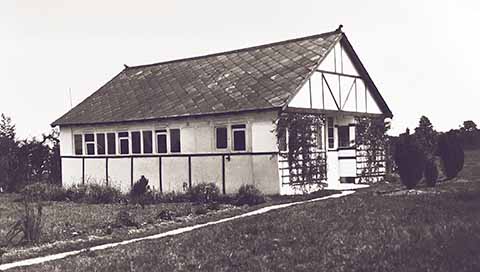
The completed house with asbestos roof. The carriages’ identity was initially disguised with a half-timbered look.
The carriages were towed on a four-wheel road-wheel bogey by steam engine down the road from Wool Station. Once in situ, they were rolled off the bogey to stand in their new position on specially laid brick foundations.
Alfred set about digging a well for water and constructing a roof over the two carriages for added waterproofing and to make the home look more traditional, an endeavour further enhanced by placing asbestos sheets over the foundations, whitewashing of the walls and the placement and painting of beams to give the carriages a ‘Tudor’ look.
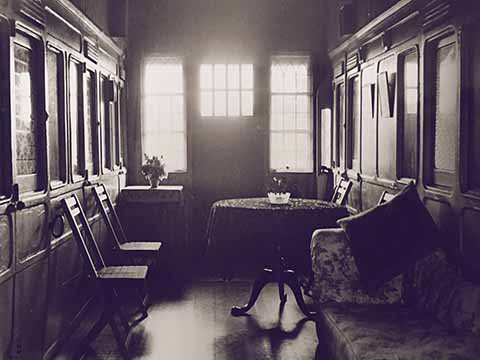
The central section of the house with its matching barrel ceiling installed when it was refurbished after its most recent movement
With Esmé and Sybil helping out whenever they were down in Dorset, the home took shape and the garden was established and the little railway house became a beloved holiday home.
With the advent of World War 2, the house was chosen as a billet for fifteen evacuees, who, unable to cope with the quiet of country life, upped sticks and returned to London after just six weeks. Neighbours in Wool wrote to the family to tell them the house had its windows and doors open and no-one seemed to be there.
Alfred and Sybil made the long drive down and were heartbroken to find the house in such a state, with a half finished meal on the table, much of the furniture broken. They tidied up as best they could, padlocked the little house and went home. ‘Well,’ Alfred said, ‘we must just start again when the war is over.’
Alfred didn’t survive to see the family come back to the little railway house in Wool, but Fanny, her daughter Esmé and her children (the current owners, David and Alison) came for their first visit to Granny’s Trainhouse.
Instead of a cottage garden, the house was surrounded by potato plants as the land had been requisitioned by the Ministry of Food to help with the supply of food for rationing.
The war eventually came to an end, and mains water and electricity came to Granny’s Trainhouse. The house was repainted and the cottage came back to life.
When Fanny died, her family buried the final tier of cake from Fanny and Albert’s wedding fifty years before in the Dorset soil.
David and Alison have continued to care for Granny’s Trainhouse and a few years ago decided to build a more substantial house on the plot. And so, for the final time, the carriages of the little trainhouse made a move, this time just a few yards further towards the road to make room for the new building.
David and Alison also took the opportunity to completely refurbish the house, placing the train carriages exactly the same distance apart as each individual carriage’s width. A local carpenter created a barrel ceiling inside the new central area to make it look like there were three carriages together not just two.
The paintwork of the carriages was returned to its original pre-World War 1 livery of salmon and chocolate, which is as it looks today with its smart new veranda and new roof.
David and Alison now let out the house as a holiday home, so now new generations of children can come to Wool and experience the joy of Granny’s Trainhouse.
